
An armoured fighting vehicle or armored fighting vehicle (AFV) is an armed combat vehicle protected by armour, generally combining operational mobility with offensive and defensive capabilities. AFVs can be wheeled or tracked. Examples of AFVs are tanks, armoured cars, assault guns, self-propelled guns, infantry fighting vehicles (IFV), and armoured personnel carriers (APC).
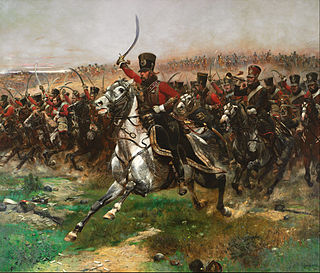
Historically, cavalry are soldiers or warriors who fight mounted on horseback. Cavalry were the most mobile of the combat arms, operating as light cavalry in the roles of reconnaissance, screening, and skirmishing in many armies, or as heavy cavalry for decisive shock attacks in other armies. An individual soldier in the cavalry is known by a number of designations depending on era and tactics, such as a cavalryman, horseman, trooper, cataphract, knight, drabant, hussar, uhlan, mamluk, cuirassier, lancer, dragoon, or horse archer. The designation of cavalry was not usually given to any military forces that used other animals for mounts, such as camels or elephants. Infantry who moved on horseback, but dismounted to fight on foot, were known in the early 17th to the early 18th century as dragoons, a class of mounted infantry which in most armies later evolved into standard cavalry while retaining their historic designation.

Infantry is a military specialization of military personnel who engage in ground combat on foot. Infantry generally consists of light infantry, mountain infantry, mobile infantry, motorized infantry, mechanized infantry, bicycle infantry, airborne infantry, airmobile infantry, and marine infantry.
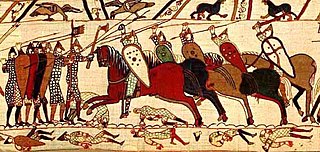
A lance is a spear designed to be used by a mounted warrior or cavalry soldier (lancer). In ancient and medieval warfare, it evolved into the leading weapon in cavalry charges, and was unsuited for throwing or for repeated thrusting, unlike similar weapons of the javelin and pike family typically used by infantry. Lances were often equipped with a vamplate, a small circular plate to prevent the hand sliding up the shaft upon impact, and beginning in the late 14th century were used in conjunction with a lance rest attached to the breastplate. Though best known as a military and sporting weapon carried by European knights and men-at-arms, the use of lances was widespread throughout Asia, the Middle East, and North Africa wherever suitable mounts were available. Lancers of the medieval period also carried secondary weapons such as swords, battle axes, war hammers, maces and daggers for use in hand-to-hand combat, since the lance was often a one-use-per-engagement weapon; assuming the lance survived the initial impact without breaking, it was often too long, heavy, and slow to be effective against opponents in a melee.
Military tactics encompasses the art of organizing and employing fighting forces on or near the battlefield. They involve the application of four battlefield functions which are closely related – kinetic or firepower, mobility, protection or security, and shock action. Tactics are a separate function from command and control and logistics. In contemporary military science, tactics are the lowest of three levels of warfighting, the higher levels being the strategic and operational levels. Throughout history, there has been a shifting balance between the four tactical functions, generally based on the application of military technology, which has led to one or more of the tactical functions being dominant for a period of time, usually accompanied by the dominance of an associated fighting arm deployed on the battlefield, such as infantry, artillery, cavalry or tanks.

Combined arms is an approach to warfare that seeks to integrate different combat arms of a military to achieve mutually complementary effects—for example, using infantry and armour in an urban environment in which each supports the other.
A frontal assault is a military tactic which involves a direct, full-force attack on the front line of an enemy force, rather than to the flanks or rear of the enemy. It allows for a quick and decisive victory, but at the cost of subjecting the attackers to the maximum defensive power of the enemy; this can make frontal assaults costly even if successful, and often disastrously costly if unsuccessful. It may be used as a last resort when time, terrain, limited command control, or low troop quality do not allow for any battlefield flexibility. The risks of a frontal assault can be mitigated by the use of heavy supporting fire, diversionary attacks, the use of cover, or infiltration tactics.
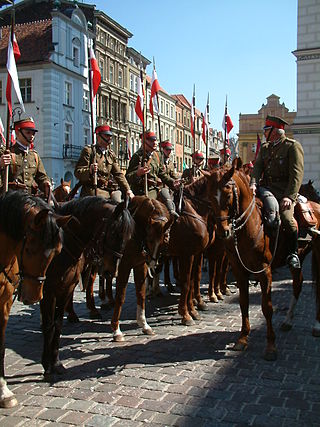
The Polish cavalry can trace its origins back to the days of medieval cavalry knights. Poland is mostly a country of flatlands and fields and mounted forces operate well in this environment. The knights and heavy cavalry gradually evolved into many different types of specialised mounted military formations, some of which heavily influenced western warfare and military science. This article details the evolution of Polish cavalry tactics, traditions and arms from the times of mounted knights and heavy winged hussars, through the times of light uhlans to mounted infantry equipped with ranged and mêlée weapons.

A charge is an offensive maneuver in battle in which combatants advance towards their enemy at their best speed in an attempt to engage in a decisive close combat. The charge is the dominant shock attack and has been the key tactic and decisive moment of many battles throughout history. Modern charges usually involve small groups of fireteams equipped with weapons with a high rate of fire and striking against individual defensive positions, instead of large groups of combatants charging another group or a fortified line.
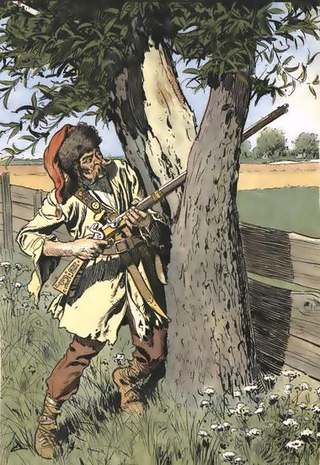
Skirmishers are light infantry or light cavalry soldiers deployed as a vanguard, flank guard or rearguard to screen a tactical position or a larger body of friendly troops from enemy advances. They are usually deployed in a skirmish line, an irregular open formation that is much more spread out in depth and in breadth than a traditional line formation. Their purpose is to harass the enemy by engaging them in only light or sporadic combat to delay their movement, disrupt their attack, or weaken their morale. Such tactics are collectively called skirmishing.
The caracole or caracol is a turning maneuver on horseback in dressage and, previously, in military tactics.

Shock troops or assault troops are formations created to lead an attack. They are often better trained and equipped than other infantry, and expected to take heavy casualties even in successful operations.
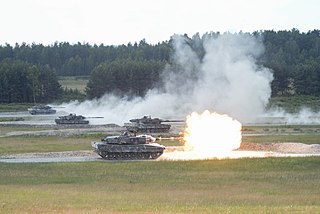
Armoured warfare or armored warfare, is the use of armoured fighting vehicles in modern warfare. It is a major component of modern methods of war. The premise of armoured warfare rests on the ability of troops to penetrate conventional defensive lines through use of manoeuvre by armoured units.

Infantry tactics are the combination of military concepts and methods used by infantry to achieve tactical objectives during combat. The role of the infantry on the battlefield is, typically, to close with and engage the enemy, and hold territorial objectives; infantry tactics are the means by which this is achieved. Infantry commonly makes up the largest proportion of an army's fighting strength, and consequently often suffers the heaviest casualties. Throughout history, infantrymen have sought to minimise their losses in both attack and defence through effective tactics.

Tank desant is a military combined arms tactic, where infantry soldiers ride into an attack on tanks, then dismount to fight on foot in the final phase of the assault. Note that this differs from infantry troops merely riding on tanks as a form of ad-hoc transportation. Desant is a pan-Slavic general term for airborne or parachute drops and naval infantry amphibious landing operations.

The Byzantine army evolved from that of the late Roman period taking as leading models and shaping itself on the late Hellenistic armies, but it became considerably more sophisticated in strategy, tactics and organization. The language of the army was still Latin, although later Greek dominated, as it became the official language of the entire empire. Unlike the Roman legions, its strength was in its cavalry, especially the armoured cataphracts, which evolved from the clibanarii of the late empire. Infantry were still used but mainly as a base of maneuver for the cavalry, as well as in specialized roles. Most of the foot-soldiers of the empire were the armoured skutatoi and later on, kontarioi, with the remainder being the light infantry and archers of the psiloi. The Byzantines valued intelligence and discipline in their soldiers far more than bravery or brawn. The "Ρωμαίοι στρατιώται"(rōmaíoi stratiōtai) were a loyal force composed of citizens willing to fight to defend their homes and their state to the death, augmented by mercenaries. The training was very much like that of the legionaries, with the soldiers taught close combat techniques with their swords, spears and axes, along with the extensive practice of archery.

Heavy cavalry was a class of cavalry intended to deliver a battlefield charge and also to act as a tactical reserve; they are also often termed shock cavalry. Although their equipment differed greatly depending on the region and historical period, heavy cavalry were generally mounted on large powerful warhorses, wore body armor, and armed with either lances, swords, maces, flails (disputed), battle axes, or war hammers; their mounts may also have been protected by barding. They were distinct from light cavalry, who were intended for scouting, screening, and skirmishing.

For much of history, humans have used some form of cavalry for war and, as a result, cavalry tactics have evolved over time. Tactically, the main advantages of cavalry over infantry troops were greater mobility, a larger impact, and a higher position.

The first depictions of four-wheeled wagons pulled by semi-domesticated onagers and other available animals come from the Sumerians.
Napoleonic tactics describe certain battlefield principles used by national armies from the late 18th century until the invention and adoption of the rifled musket in the mid 19th century. Napoleonic tactics are characterized by intense drilling of the soldiers; speedy battlefield movement; combined arms assaults between infantry, cavalry, and artillery; and a relatively small numbers of cannon, short-range musket fire, and bayonet charges. Napoleon I is considered by military historians to have been a master of this particular form of warfare. Napoleonic tactics continued to be used after they had become technologically impractical, leading to large-scale slaughters during the American Civil War, Austro-Prussian War and the Franco-Prussian War.
















